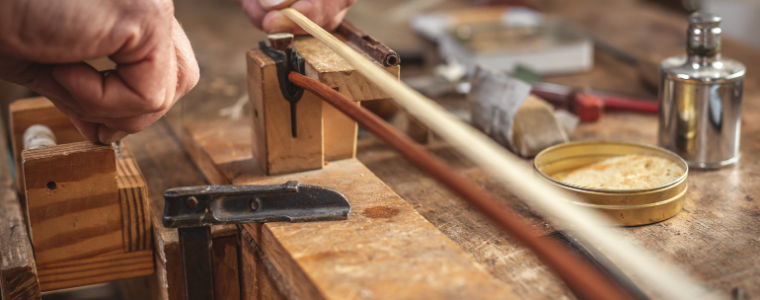What are the Characteristics of an Excellent Bow?

String instrument bows, like the instruments themselves, come in a range of different qualities and price points. As a beginner, you are best off renting an instrument and bow from a reputable shop as you determine whether the string musician’s journey is for you.
Once you graduate to intermediate and advanced string playing status, it’s time to think about upgrading your equipment.
Bows Need Upgrades too
Our earlier post, When Is It Time to Upgrade Your Violin? addressed the violin itself. Today we want to talk about what to look for when you’ve decided to upgrade your bow.
During a 2006 interview with NPR’s Renee Montagne, founder and violist of the American Chamber Players, Miles Hoffman, detailed the importance of bow quality and which characteristics separated excellent bows from lower-quality counterparts. Hoffman explained, “I think a perfect analogy is that the bow is for the string player what breath is for the singer. And, one of the reasons that good bows are so prized is that they are so versatile."
Let’s examine the most important characteristics to look for when shopping for your next bow. Whether you play the violin, viola, cello, or bass, excellent bows have four things in common: strength, flexibility, balance, and gorgeous sound.
Strength: Wood vs Carbon/Synthetic
So much emphasis is put on the instrument’s body and strings, but have you deeply considered how much work the bow does to produce the sounds you want? And, it does all of that while strung taut with the tension of tightened bow hair.
To put up with all of the various bowing styles you’ll use over the course of your playing lifetime, not to mention the knocks, bumps, and clunks a bow experiences as it moves in and out of your case and in the world-at-large, bow structures must be strong and resilient. For this reason, some of the most celebrated bows in the world (which can sell for up to $100,000) are made from the hard exotic wood of pernambuco trees.
Pernambuco
While brazilwood also makes high-quality wood bows, string players in the market for a superior fine wood bow consider nothing less than the revered pernambuco options.
Native to Brazilian rainforests, pernambuco trees have been harvested and sold to luthiers and bow manufacturers in Europe and North America for hundreds of years. However, the scarcity of the resource, now protected by a global network of artisans (read Saving the Music Tree), innovative bow makers started experimenting with carbon fiber composites.
Carbon fiber
Today, it's widely accepted that carbon fiber bows, made from fiber composites fused, rival the sounds produced by their wooden counterparts. Carbon composite bows have all of the strength and flexibility attributed to wood bows but are more affordable and sustainable. Plus, unlike wood bows, they are less susceptible to temperature and humidity fluctuations and are far less fragile or prone to breaking.
Read Should I Buy A Wood Bow or A Carbon Fiber Composite Bow…, to learn more about your options.
Flexibility: Stiff and Bendable
Bows have to meet a dichotomous request, which is to be both stiff and flexible. This is one of the reasons wood bows are made from hardwood species. Both brazilwood and pernambuco are incredibly hard, but the trees are also able to bend in the wind, the same type of stiff bendability required of a bow.
If your bow is too stiff, it will only access the top of the strings, yielding a hollow or scratchy tone. A flexible bow, on the other hand, allows the strings to make deeper contact with the strings and the result is a more rich and full tone. As an experienced string player, you’ll feel this difference immediately, which will help guide your selection.
Balance: Where’s the Center?
Bows are like humans, they have their own center of gravity (or center of balance), and this affects how they move. Too much weight at the tip and, in a short amount of time, the bow will feel heavy and cumbersome to move across the strings. This can also lead to wrist problems. If the weight is centered too close to the frog, the bow feels too light. That may feel great at first but ultimately creates control problems.
Excellent bows are balanced to achieve the trifecta. They have enough weight at the tip to exert control without fatigue, sufficient weight on the frog-end to optimize the number of hairs that make contact with the strings, and they facilitate a smooth bowing experience.
Excellent Sound: The End Goal
Ultimately, excellent bows should elicit excellent sounds. As with violins, you may be surprised to learn you prefer the sound and feel of a less expensive bow, or you may learn your favorite sound is produced by a bow that is above your originally slated budget.
There is a bow (or two or three) for every advanced string musician, and you’ll learn which bows you prefer to use based on the styles of music you play or the bowing techniques required to play a specific composition. In either case, it requires trying out a wide range of different bows and determining which one feels and sounds best to you.
Are you ready to upgrade? Now that you know more about the characteristics of an excellent bow, we recommend experimenting with Revelle’s line of world-class bows. They are available in pernambuco, brazilwood, carbon fiber, and composite options and designed for every level of playing experience and budget.

